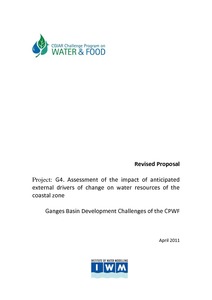Resource information
This project will address the important external drivers that influence water resources of the coastal zone and to assess the anticipated changes in flooding, drainage congestions, salinity intrusion, water availability, sedimentation and risk of inundation of cyclone induced storm surge as a consequence of these drivers. The water resources in the coastal zone of the Ganges basin are vital for crop production, ecosystem sustenance and livelihoods. These resources are largely shaped by tidal dynamics and upstream flows, and are affected by changes in the natural, socio-economic and institutional systems. It is important to identify and prioritize these drivers, and assess their effects on water resources towards building resilient water governance and management to cope with the projected future conditions.
Key activities of the project are: review of the existing model studies, literature, available data and collection of data; identification and ranking of external drivers; adaptation, calibration and validation of Soil Water Assessment Tool (SWAT) and Water Evaluation And Planning System (WEAP) models for assessing baseline hydrological conditions; setup, calibration and validation of Ganga-Brahmaputra-Meghna (GBM) basin model, South West Regional Model (SWRM), and Bay of Bengal (BoB) model; assessment of water flow pattern, salinity distribution, storm surge risk, sedimentation pattern in baseline and projected conditions; assessment of adaptation strategies to changes caused by key drivers; and exploration of policy implications for adaptation strategies and water governance.
Key outputs of the project include: list of key external drivers; climate change projections for the study region; projection of scenarios for land-use and climate change; flow availability; salinity zoning map of the coastal Ganges; flood depth-duration map; water storage volume inside polders; storm surge risk map; sedimentation rate in peripheral rivers; plan for improvement of khal system, sluices and embankments; operation rules for sluices.
Methodology: This project will develop a comprehensive list of external drivers based on past researches, global literature review, interaction with the major stakeholders and peers. This list will then be put under a well designed priority and ranking criteria for identification of the key drivers contributing to about 85-90% of the anticipated changes. On the basis of performance and field validation, appropriate models will be selected for studying the baseline conditions and effects of external drivers on salinity intrusion, water availability, drainage congestions and risk of inundation due to storm surges. The models available with IWM and partner organizations will be utilized to simulate the baseline and changed conditions in 2020, 2030 and 2050. The study will be conducted at two scales: regional level for the coastal regions of Bangladesh and at local level for the selected polders. On the basis of the anticipated impacts different adaptation strategies will be devised such as improvement of the land-use patterns, drainage canals, operation of sluices, strengthening of embankments, dredging, restoration of dry season freshwater flow for flushing salinity as well as restoration of the ecosystem. Specific adaptation strategies for choice and selection of the crops/aquaculture during different seasons and their salinity and submergence tolerance will be developed in consultation with G2 and G3 projects. Policy implications on these strategies and a required governance structure will be also explored in a participatory way. The implications of major national policies in the realm of national water policies, agricultural policy, environment policy, disaster management policy, and climate change adaptation strategy and action plan (BCCSAP) will be particularly emphasized.
Likely Impacts: The output of this project is expected to be reflected in water use of local farmers and fishermen, water management by water control system managers and planning of the policymakers.


